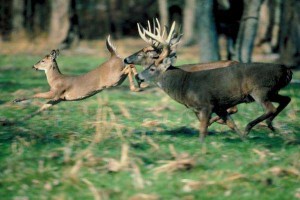 Toxoplasmosis, a one-celled parasite found in many meats, can occur in South Carolina deer, but venison is not the only source of the disease, says a state Department of Natural Resources deer biologist.
Toxoplasmosis, a one-celled parasite found in many meats, can occur in South Carolina deer, but venison is not the only source of the disease, says a state Department of Natural Resources deer biologist.
“Many people concerned about eating venison, or deer meat, have called the department asking about the likelihood of exposure to toxoplasmosis,” said Charles Ruth, Statewide Deer/Turkey Project supervisor for the Wildlife Section of the S.C. Department of Natural Resources (DNR). “Although the disease is often mentioned only in conjunction with venison, it can be found in many domestic meats including beef, pork, and sheep. Once you become aware of how the disease works, chances of exposure can be minimized, and venison can be safely consumed.”
Toxoplasmosis is caused by a microscopic protozoan parasite, and it is one of the most common diseases transmitted from animals to humans. Authorities estimate that 30 to 60 percent of adults in the United States have been exposed to the parasite, but the organism rarely causes disease. Although most human infections are silent, there may be brief flu-like symptoms in some cases. The greatest risk of real illness in humans would likely be in someone whose immune system is already compromised.
Since white-tailed deer can be infected with the toxoplasmosis organism, there is a chance that humans can become infected if the meat is not properly handled. This is also true for common domestic meats as well.
Sportsmen can minimize their risks of toxoplasmosis infection by following these guidelines with venison: 1) do not handle fresh carcasses or meat with wounds on their hands; 2) freeze all meat before cooking because freezing kills the majority of the parasites; and 3) cook venison thoroughly (160ºF).
Although toxoplasmosis normally does not cause illness in humans, women who are pregnant or are planning a pregnancy should be particularly careful. The effect of toxoplasmosis upon an unborn fetus can be severe.
If a woman is pregnant or planning a pregnancy, she should: 1) minimize contact with cats and their litter boxes; 2) handle all meats carefully; 3) cook all meats thoroughly before eating; 4) freeze all red meats prior to cooking; and 5) minimize contact with soil or dirt when gardening.
In 1981, Karen Oertley, a student at the University of Georgia, completed a study of toxoplasmosis in white-tailed deer. This effort also combined information on the disease from other studies around the world. “Several points of Oertley’s toxoplasmosis study are of particular interest to deer hunters and others who eat venison,” Ruth said.
According to Oertley’s study, the prevalence of toxoplasmosis in white-tailed deer in the Southeast was 24.4 percent. On the other hand, surveys conducted at commercial slaughter houses to determine the prevalence of this organism in domestic meats indicated a great variance in occurrence, but infection rates as high as 64 percent for sheep, 45 percent for swine and 38 percent for cattle were found among animals to be used as human food.
Natural infections of toxoplasmosis have been reported in more than 200 species of mammals, Oertley found in the study. Prevalence is naturally higher in carnivores, or meat-eating animals, than in herbivores, such as cattle and deer.
According to the study, probably the greatest risk for human toxoplasmosis infection is the presence of cats in and around homes. Members of the cat family are the only suitable definitive host for the parasite. Cats kill and eat wild rodents, which are also part of the parasite’s life cycle, and shed the organism in their feces. This in turn can contaminate the soil and/or water, which increases the likelihood of exposure to other types of mammals and birds. Although not a necessary part of the parasite’s life cycle, herbivorous animals like deer probably get the parasite from these contaminated soil or water sources.
“It would be nearly impossible to totally prevent the risk of exposure to the parasite because of its distribution in soil or water contaminated by cat feces,” Ruth said. “This, and the fact that the organism can be found in so many types of meats, likely explains why such a high percentage of people have been exposed to the organism.”
According to Ruth, “The bottom line is that toxoplasmosis is not just related to deer meat. Evidence suggests that the potential for contracting the disease from venison is probably the same as it is from domestic meats. Healthy people in general should not be overly concerned with the disease since there is a good chance they have already been exposed to it. Precautionary measures are most important for high-risk individuals such as pregnant women and people with some pre-existing condition that has compromised their immune system.”

